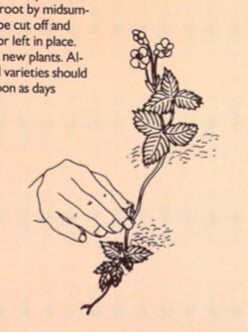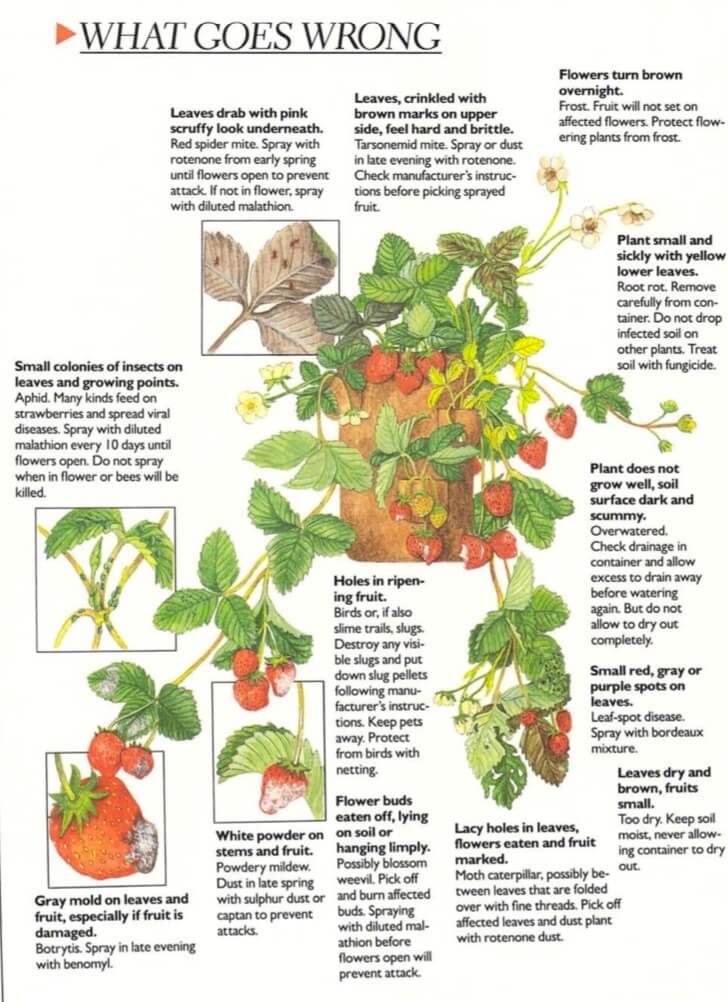[Ebook Việt Hoá] The Instant Guide to Healthy Houseplants (Hướng dẫn tức thời để chăm cây trong nhà khoẻ mạnh), Chi Fragaria - Chi Dâu Tây
[Ebook Việt Hoá] The Instant Guide to Healthy Houseplants: Fragaria (Strawberry)
- Nguồn: [Ebook Việt Hoá] The Instant Guide to Healthy Houseplants (Hướng dẫn tức thời để chăm cây trong nhà khoẻ mạnh)
- Biên tập: Dũng Cá Xinh
- Biên dịch: Team Codai.net
English
Luscious, juicy strawberries can be grown successfully in window boxes, tubs or special strawberry barrels if they are in an open location in good light. The fruits should be raised off the soil by using straw or similar mulching materials. For a good crop the following year, plant in late spring or early summer; if planting later, pick off the first flowers next year to build up a vigorous plant for an autumn crop.

Light
Prefers full light in open location.
Temperature
Prefers warm, sunny environment when bearing fruit. Will survive frost, but fruits will not form; so protect from spring frosts.
Water
Never allow plants to dry out.
Feeding
If planting in midsummer, feed in early autumn with top dressing of bone meal (1 oz per sq yd, 28 g per sq m). When new growth appears in spring, give liquid feed every week until fruits are ripe. For plants 2 and 3 years old, add fish, blood or complete bone fertilizer to top soil in midsummer, then feed as first-year plants in autumn.
Humidity
They need a dry atmosphere. Do not spray when bearing fruit.
Soil
Use loam-based soil, soilless potting mix or equal parts of each.
Maintenance
Remove yellow leaves. Cut runners off if not propagating, or leave as decoration over side of container.
Varieties
Many varieties are available. Choose one suitable to your region of the country. It is best to choose varieties resistant to verticillum wilt, red stele and viruses.
Propagation
Plant produces runners (small plantlets on tips of trailing stems). Peg them to soil with 3-in (8-cm) wire staples. New plantlets will root by midsummer and can be cut off and transported or left in place. Then treat as new plants. Alpine and seed varieties should be sown as soon as days lengthen.

What Goes Wrong

- Flowers turn brown overnight: Frost. Fruit will not set on affected flowers. Protect flowering plants from frost.
- Plant small and sickly with yellow lower leaves: Root rot. Remove carefully from container. Do not drop infected soil on other plants. Treat soil with fungicide.
- Plant does not grow well, soil surface dark and scummy: Overwatered. Check drainage in container and allow excess to drain away before watering again. But do not allow to dry out completely.
- Small red, gray or purple spots on leaves: Leaf-spot disease. Spray with bordeaux mixture.
- Leaves dry and brown, fruits small: Too dry. Keep soil moist, never allowing container to dry out.
- Small colonies of insects on leaves and growing points: Aphid. Many kinds feed on strawberries and spread viral diseases. Spray with diluted malathion every 10 days until flowers open. Do not spray when in flower or bees will be killed.
- Gray mold on leaves and fruit, especially if fruit is damaged: Botrytis. Spray in late evening with benomyl.
- White powder on stems and fruit: Powdery mildew. Dust in late spring with sulphur dust or captan to prevent attacks.
- Holes in ripening fruit: Birds or, if also slime trails, slugs. Destroy any visible slugs and put down slug pellets following manufacturer’s instructions. Keep pets away. Protect from birds with eaten off, lying on sailor hanging limply. Possibly blossom weevil. Pick off and burn affected buds. Spraying with diluted mal-athion before flowers open will prevent attack.
- Leaves drab with pink scruffy look underneath: Red spider mite. Spray with rotenone from early spring until flowers open to prevent attack. If not in flower, spray with diluted malathion.
- Leaves, crinkled with brown marks on upper side, feel hard and brittle: Tarsonemid mite. Spray or dust in late evening with rotenone. Check manufacturer’s instructions before picking sprayed fruit.
- Lacy holes in leaves, flowers eaten and fruit marked: Moth caterpillar, possibly between leaves that are folded over with fine threads. Pick off affected leaves and dust plant with rotenone dust.
Tiếng Việt
Dâu tây ngon ngọt có thể được trồng thành công bên ô cửa sổ, chậu hoặc thùng dâu tây đặc biệt nếu chúng ở vị trí thoáng, có ánh sáng tốt. Quả nên được nâng lên khỏi đất bằng rơm rạ hoặc các vật liệu tương tự. Để vụ mùa năm sau tốt tươi nên trồng vào cuối mùa xuân hoặc đầu mùa hè; nếu trồng muộn hơn, hãy hái những bông hoa đầu tiên vào năm sau để tạo sức sống cho cây vào vụ thu.

Ánh sáng
Thích ánh sáng đầy đủ ở vị trí thoáng.
Nhiệt độ
Thích môi trường nắng ấm khi ra trái. Tồn tại được trong sương giá, nhưng hoa và quả sẽ không nở; vì vậy hãy bảo vệ khỏi sương giá mùa xuân.
Nước
Không bao giờ để cây bị khô.
Bón phân
Nếu trồng vào giữa mùa hè, bón phân vào đầu mùa thu bằng cách bón thúc bột xương (1 oz mỗi m2, 28 g mỗi m2). Khi chồi mới xuất hiện vào mùa xuân, sử dụng phân bón dạng lỏng hàng tuần cho đến khi trái chín. Đối với cây 2 và 3 tuổi, bón thêm đạm cá hoặc phân bón hoàn chỉnh vào đất vào giữa mùa hè, sau đó bón thúc như cây năm thứ nhất vào mùa thu.
Độ ẩm
Chúng cần một bầu không khí khô ráo. Không phun thuốc khi đang ra trái.
Đất
Sử dụng đất mùn, hỗn hợp không đất hoặc các phần bằng nhau của mỗi loại.
Duy trì
Loại bỏ lá vàng. Cắt bỏ những cây bò lan nếu không nhân giống, hoặc để lại làm vật trang trí bên ngoài thùng chứa.
Các loài
Nhiều loại có sẵn. Chọn một loài phù hợp với khu vực đất của bạn. Tốt nhất nên chọn giống kháng bệnh héo rũ, nấm tảo và vi rút.
Nhân giống
Cây sẽ mọc ra những cây thân bò (cây con nhỏ trên đầu của thân cây). Cắm chúng vào đất bằng kim ghim dây 3 inch (8 cm). Cây con mới sẽ mọc rễ vào giữa mùa hè và có thể được cắt ra và di chuyển hoặc để nguyên tại chỗ. Sau đó coi như cây mới. Các giống Alpine và hạt giống nên được gieo càng sớm càng tốt.

Những vấn đề có thể xảy ra

- Hoa chuyển sang màu nâu qua đêm: Sương giá. Quả sẽ không nở trên những bông hoa bị ảnh hưởng. Bảo vệ cây có hoa khỏi sương giá.
- Cây nhỏ và bị bệnh vàng lá phía dưới: Thối rễ. Loại bỏ cẩn thận khỏi chậu. Không làm rơi đất nhiễm bệnh lên cây khác. Xử lý đất bằng thuốc diệt nấm.
- Cây phát triển không tốt, bề mặt đất sẫm màu và có váng: Tưới quá nhiều. Kiểm tra hệ thống thoát nước trong thùng chứa và để nước thừa thoát ra ngoài trước khi tưới lại. Nhưng không để khô hoàn toàn.
- Các đốm nhỏ màu đỏ, xám hoặc tím trên lá: Bệnh đốm lá. Xịt hỗn hợp bordeaux.
- Lá khô và nâu, quả nhỏ: Quá khô. Giữ ẩm cho đất, không bao giờ để thùng bị khô.
- Côn trùng nhỏ trên lá và chồi mới: Rệp. Nhiều loại ăn dâu tây và lây lan bệnh virus. Phun malathion pha loãng 10 ngày một lần cho đến khi hoa nở. Không phun khi đang có hoa nếu không ong sẽ bị chết.
- Mốc xám trên lá và quả, đặc biệt nếu quả bị hư: Nấm mốc. Xịt vào buổi tối với benomyl.
- Bột trắng trên thân và quả: Bệnh phấn trắng. Vào cuối mùa xuân Rắc bột lưu huỳnh hoặc captan để tránh bị tấn công.
- Các lỗ trên quả chín: Chim hoặc sên. Loại bỏ tất cả sên có thể nhìn thấy và đặt viên sên theo hướng dẫn của nhà sản xuất. Tránh xa vật nuôi. Bảo vệ cây khỏi những con chim. Có thể sẽ nở hoa mọt. Cắt bỏ và đốt các chồi bị ảnh hưởng. Phun thuốc malathion pha loãng trước khi hoa nở sẽ ngăn được bệnh.
- Những chiếc lá xám xịt với những vết loang lổ màu hồng nhìn bên dưới: Nhện đỏ. Phun bằng rotenone từ đầu mùa xuân cho đến khi hoa nở để ngăn chặn sự tấn công. Nếu không ra hoa thì phun malathion pha loãng.
- Lá nhăn nheo với những vết màu nâu ở mặt trên, sờ vào thấy cứng và giòn: Mạt nhện trắng. Phun hoặc quét bụi vào buổi tối muộn bằng rotenone. Kiểm tra hướng dẫn của nhà sản xuất trước khi hái quả đã phun thuốc.
- Các lỗ khuyết trên lá, hoa bị ăn và quả xuất hiện vết: Sâu bướm xuất hiện giữa các lá được gấp lại. Nhặt bỏ các lá bị ảnh hưởng và rắc lên cây bột rotenone.
![[Ebook Việt Hoá] The Instant Guide to Healthy Houseplants: Fragaria (Strawberry) [Ebook Việt Hoá] The Instant Guide to Healthy Houseplants: Fragaria (Strawberry)](https://vn1.vdrive.vn/codai.net/2020/02/ebook-huong-dan-tuc-thoi-cham-cay-trong-nha-khoe-manh-135-fragaria.jpg)


